Embrace the Art of Hygge: Transform Your Living Room into a Cozy Sanctuary
Creating a space that soothes the soul and calms the senses has never been more important. In today’s fast-paced world, the Danish concept of hygge (pronounced “hoo-gah”) offers a much-needed antidote. Rooted in comfort, warmth, and a sense of well-being, hygge isn’t just a design style—it’s a lifestyle philosophy that celebrates the joy of simple pleasures and cozy living.
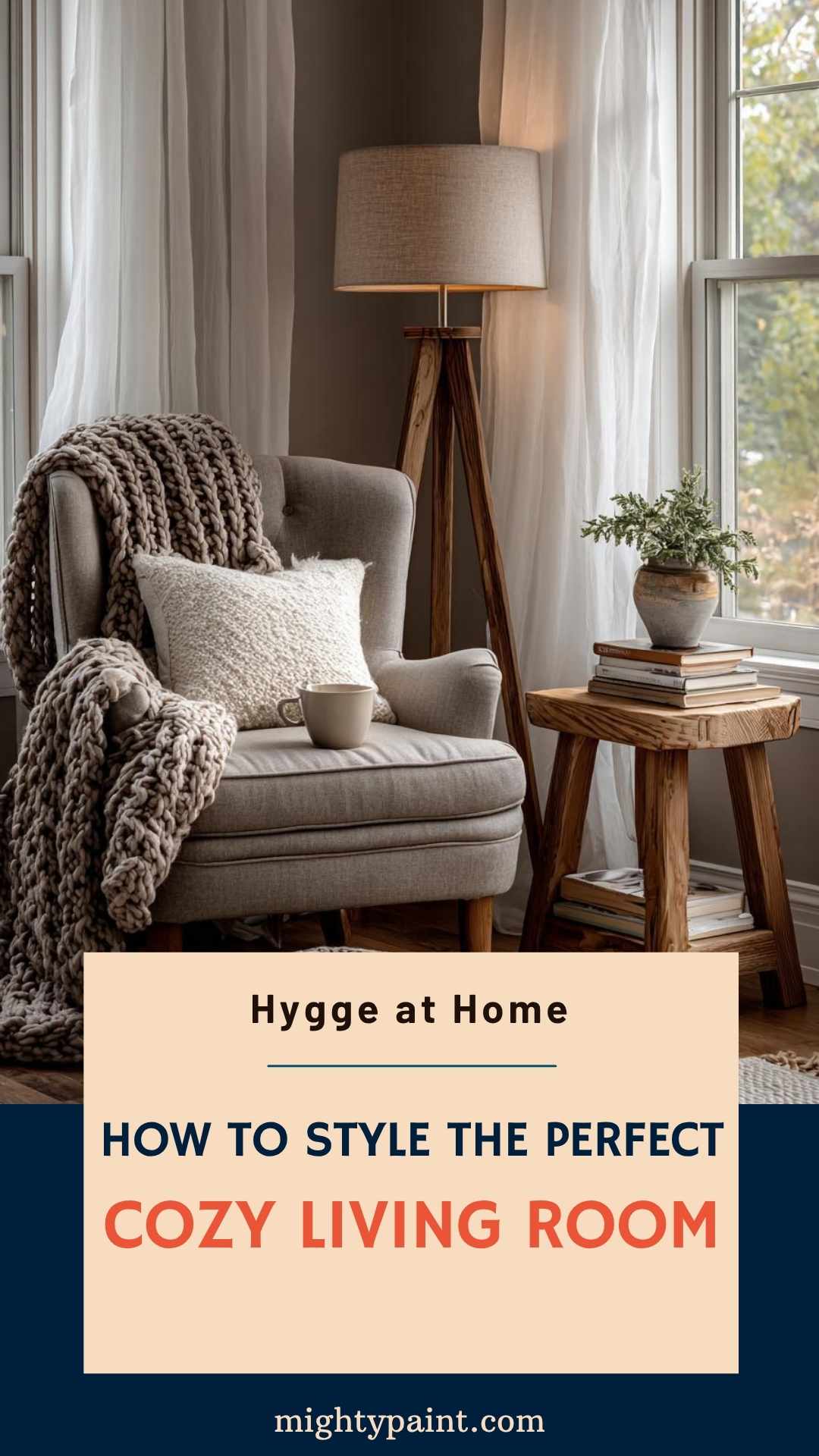
Imagine curling up with a blanket, a warm mug in hand, soft lighting flickering, and a sense of serenity wrapping around you like a gentle hug. That’s the essence of a hygge living room. It’s a space that invites relaxation, encourages meaningful moments, and feels effortlessly welcoming—no matter the season.
Get the Fail-Safe Paint Color Playbook (Free PDF)
36 proven colors • 8 ready palettes • trim & sheen guide • printable testing cards.
Whether you’re redesigning a space or making small tweaks, incorporating hygge into your living room is about creating a haven that nurtures both body and mind. In this guide, we’ll explore how to transform your living room into a cozy sanctuary, step by step, inspired by the timeless principles of hygge.
Understanding the Essence of Hygge
At its core, hygge is all about creating an atmosphere of coziness, comfort, and contentment. Originating from Denmark, where long, dark winters are the norm, this concept emphasizes the importance of small, enjoyable moments that make life feel richer. It’s less about material things and more about the feeling a space evokes—warmth, peace, and togetherness.
The essence of hygge lies in slowing down and appreciating the now. It’s about curling up with a book on a rainy day, sharing a warm drink with a friend, or enjoying the soft glow of candlelight. These moments are not grand or extravagant—they’re simple and deeply satisfying. A hygge-inspired living room should encourage relaxation and foster a sense of well-being through thoughtful design choices.
Unlike other interior styles focused purely on aesthetics or function, hygge blends both with emotional intention. While minimalism can feel sterile and maximalism can feel overwhelming, hygge strikes a comforting balance. It’s about creating a space that feels lived-in and loved, where every object serves a purpose—whether practical or sentimental.
Crafting a Hygge Color Palette
Color plays a fundamental role in setting the mood of a hygge living room. The goal is to create a serene, inviting environment that soothes rather than stimulates. Neutral and earthy tones are the foundation of this aesthetic, echoing the natural world and promoting tranquility.
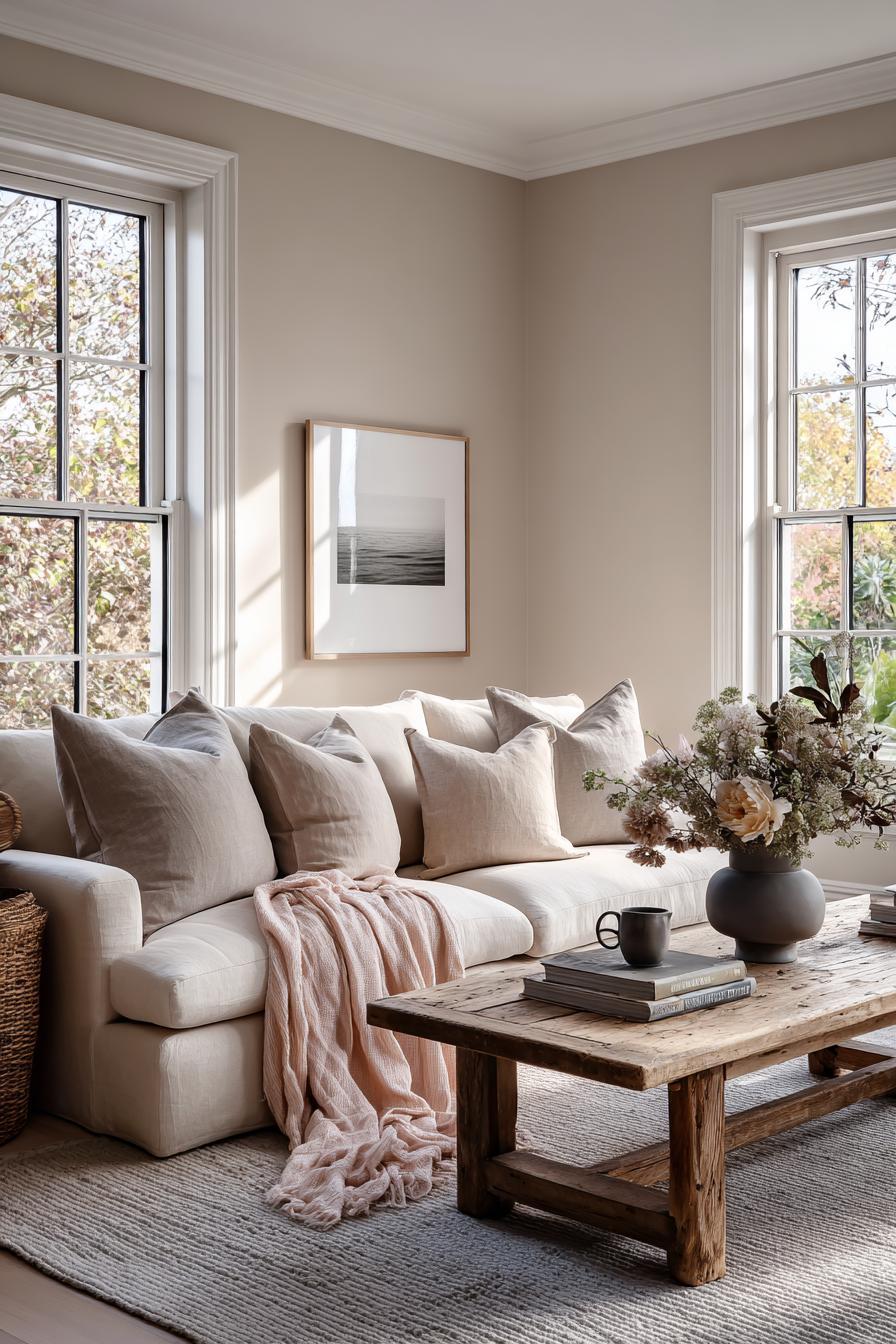
Start with a base of soft whites, beiges, and warm grays. These shades reflect natural light beautifully and form a calm backdrop for your space. Muted browns, taupes, and subtle pastel hues can add warmth without overwhelming the senses. Incorporating these tones through wall paint, upholstery, and textiles helps establish a cohesive and peaceful atmosphere.
For depth and personal flair, consider layering in accent colors inspired by nature—forest green, deep navy, or burnt terracotta. These should be used sparingly to maintain the overall sense of calm. Whether it’s a throw pillow or a piece of artwork, these touches add richness and prevent the room from feeling flat or sterile.
Pro Tips: Use our Color Palette Generator Tool for your desired colors.
Selecting Furniture with Hygge in Mind
Comfort is paramount in hygge design, and furniture choices should reflect this principle. Opt for pieces that invite lounging, like plush sofas, overstuffed armchairs, and deep-seated loveseats. The aim is to create a space that says, “Come in, relax, stay a while.”
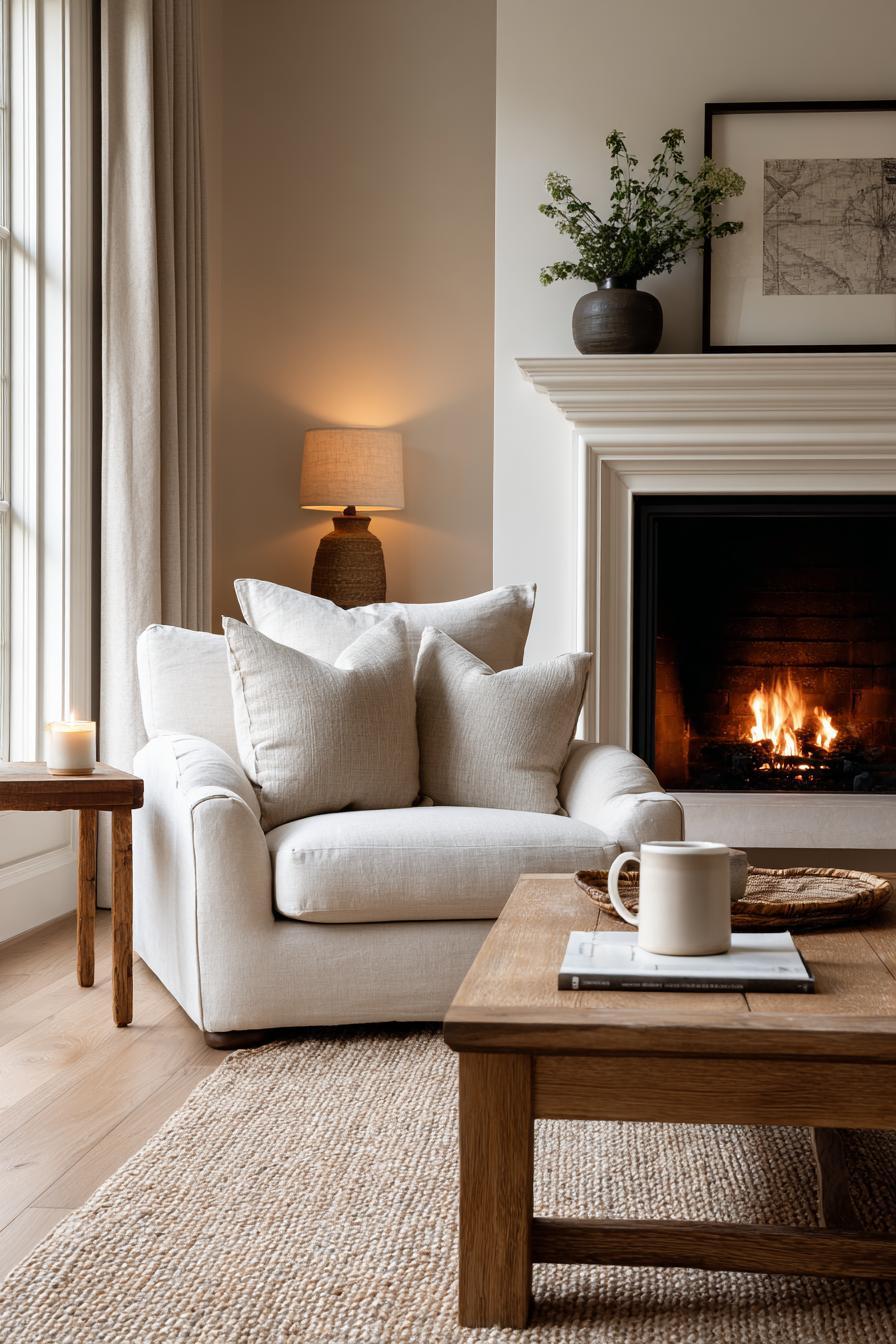
Natural materials like wood, linen, wool, and leather are essential in bringing the hygge vibe to life. These textures offer visual warmth and tactile comfort, reinforcing the connection to nature. A wooden coffee table with a weathered finish or a linen-covered armchair can make the room feel both grounded and cozy.
Furniture arrangement is just as important as the pieces themselves. Position seating to encourage conversation and closeness—think about how to draw people together. Avoid overly formal layouts and instead create intimate nooks with layered rugs, side tables, and soft lighting. A hygge living room isn’t just stylish—it’s a sanctuary designed to make everyone feel at home.
Layering Textures for Ultimate Coziness
One of the most effective ways to achieve hygge in your living room is through thoughtful layering of textures. This tactile approach not only enhances visual interest but also invites touch and comfort, key components of a cozy atmosphere.
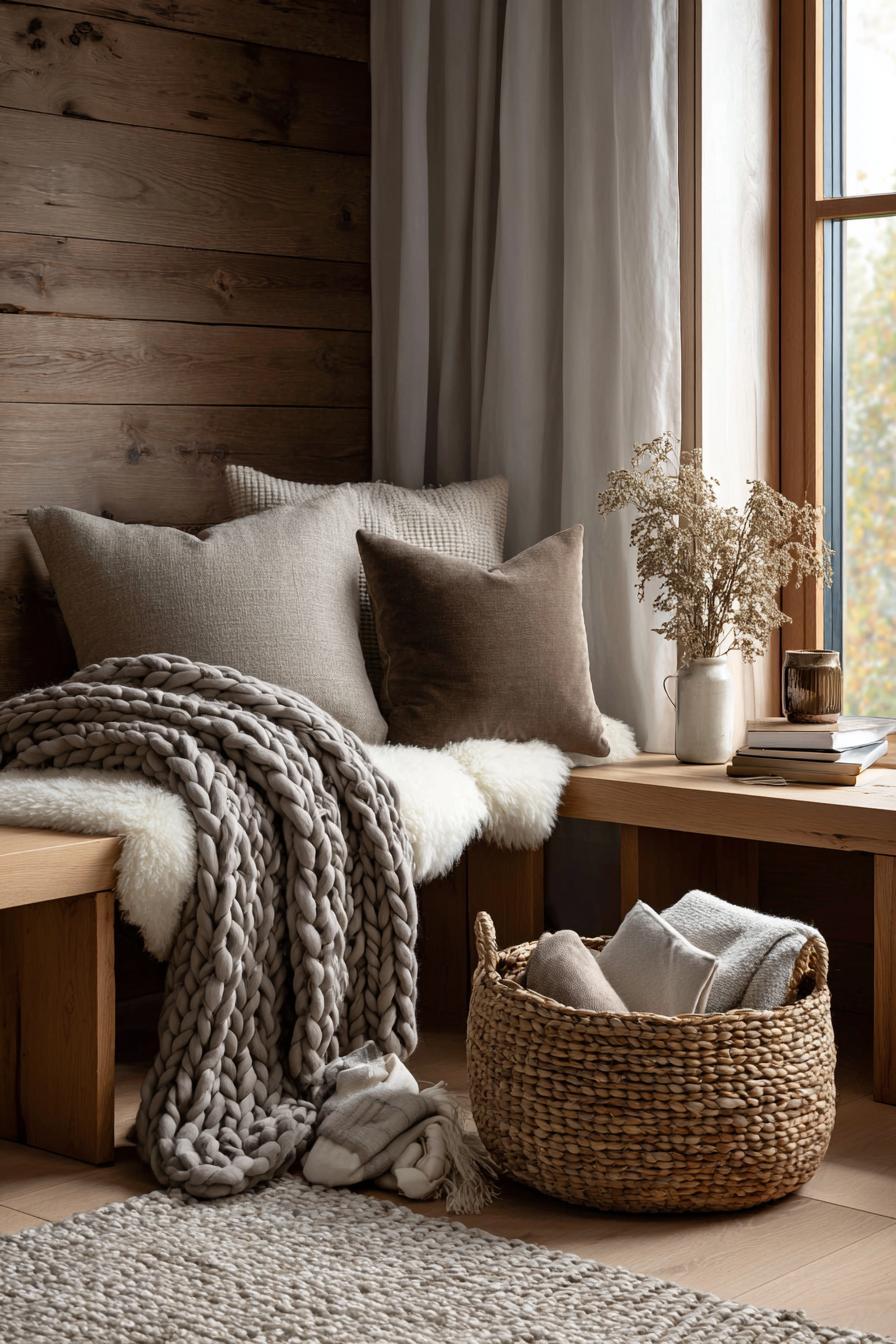
Start by incorporating a variety of soft textiles. Chunky knit throws, plush cushions, and deep-pile rugs are staples in a hygge space. These elements should feel inviting and luxurious, encouraging you to curl up and relax. Look for materials like wool, cotton, velvet, and faux fur to create a mix of textures that feel warm and soothing.
Layering isn’t just about piling on fabrics—it’s about creating a balanced and harmonious look. Combine smooth surfaces with nubby knits, or pair sleek leather with soft wool. Consider layering rugs of different sizes and textures to define spaces and add depth to the floor. A sheepskin draped over a chair or bench can instantly soften the space and add an extra touch of comfort.
Get the Fail-Safe Paint Color Playbook (Free PDF)
36 proven colors • 8 ready palettes • trim & sheen guide • printable testing cards.
The key is to make the room feel lived-in and touchable. When every surface invites interaction and every fabric begs to be snuggled, you know you’ve captured the spirit of hygge.
Lighting: Setting the Mood
Lighting is perhaps the most transformative element in a hygge living room. It sets the emotional tone of the space, creating a sense of intimacy and calm. Harsh overhead lights are the antithesis of hygge—instead, opt for soft, warm lighting that envelops the room in a gentle glow.
Get the Fail-Safe Paint Color Playbook (Free PDF)
36 proven colors • 8 ready palettes • trim & sheen guide • printable testing cards.

Natural light is ideal during the day, so keep window treatments light and airy. Linen or cotton curtains in neutral tones can filter light beautifully while maintaining privacy. In the evening, layer your lighting to build atmosphere: floor lamps, table lamps, wall sconces, and string lights can all contribute to a cozy ambiance.
Candles are a hygge essential. Their flickering flame and subtle scent can turn any evening into a soothing ritual. Scatter them across shelves, coffee tables, and window sills to create a warm, welcoming glow. Choose unscented or naturally scented varieties to maintain a tranquil environment.
Smart placement is key—think of lighting as a way to highlight cozy corners and draw attention to your favorite spaces. The goal is to bathe the room in a soft light that soothes the senses and nurtures the soul.
Incorporating Nature Indoors
Bringing the outdoors in is a hallmark of hygge design. Nature has a calming effect on the mind and body, and integrating natural elements into your living room can deepen the sense of peace and connectedness.
Indoor plants are an easy and effective way to incorporate nature. From leafy ferns to sculptural succulents, greenery adds life, color, and a breath of fresh air to your space. Choose low-maintenance varieties if you’re not a green thumb—plants like pothos, snake plants, and ZZ plants thrive with minimal care.
In addition to flora, use natural materials and finishes to reinforce the organic vibe. Wooden furniture, stone accents, and woven baskets introduce textures that ground the room and echo the serenity of the outdoors. A driftwood sculpture, a bowl of pinecones, or a vase of dried flowers can add subtle, seasonal touches.
Biophilic design—the practice of incorporating natural elements into built environments—has been shown to reduce stress and improve well-being. By embracing nature in your living room, you’re not just enhancing its aesthetic—you’re creating a space that truly nurtures.
Personal Touches: Making It Your Own
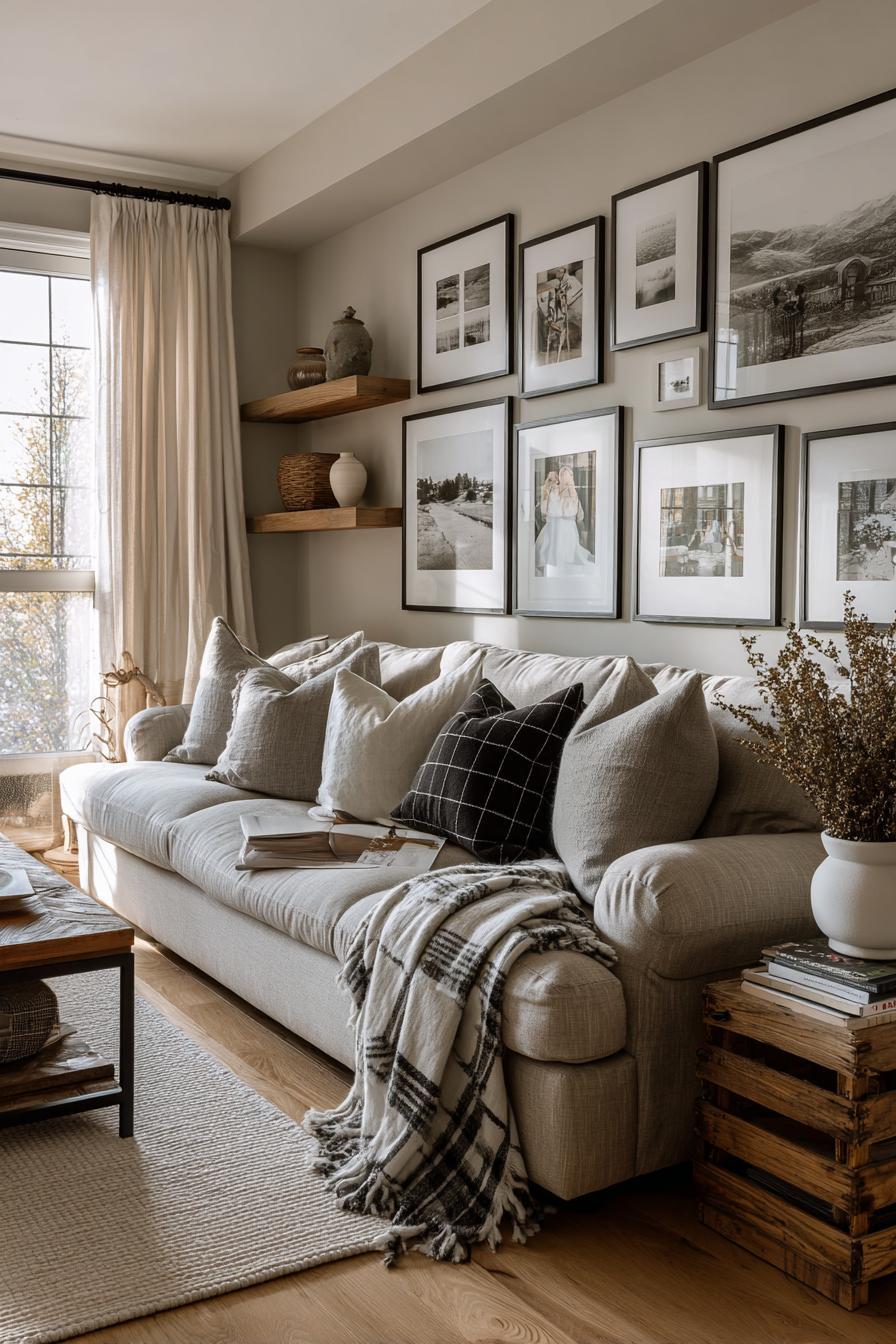
A hygge living room should be a reflection of you—your story, your comforts, and the things that bring you joy. While neutral tones and soft textures lay the foundation, personal touches are what transform the space into a heartfelt sanctuary.
Start by incorporating items with emotional value. Family photographs, heirlooms, handmade crafts, and souvenirs from travels all tell your story and bring warmth to the room. Display these pieces in thoughtful arrangements on shelves, mantels, or walls, but be mindful not to overcrowd. The goal is meaningful decoration, not clutter.
Get the Fail-Safe Paint Color Playbook (Free PDF)
36 proven colors • 8 ready palettes • trim & sheen guide • printable testing cards.
Books are another hygge essential. They bring personality and offer an invitation to slow down. Stack them on coffee tables, line them on shelves, or even use them as part of a cozy reading nook. Choose a mix of novels, art books, and vintage finds for a layered, lived-in feel.
Artwork, too, should speak to your taste and interests. Opt for pieces that evoke calm, happiness, or inspiration—whether that’s a minimalist landscape, an abstract print, or a handcrafted textile. Personalization isn’t just about aesthetics; it’s about making the room resonate emotionally with you and everyone who steps inside.
Maintaining a Clutter-Free Environment
While hygge embraces comfort and warmth, it doesn’t mean cluttered or chaotic. A clean, organized space is essential for creating the calm and serene environment that defines hygge. Clutter distracts from relaxation and can make even the coziest room feel overwhelming.
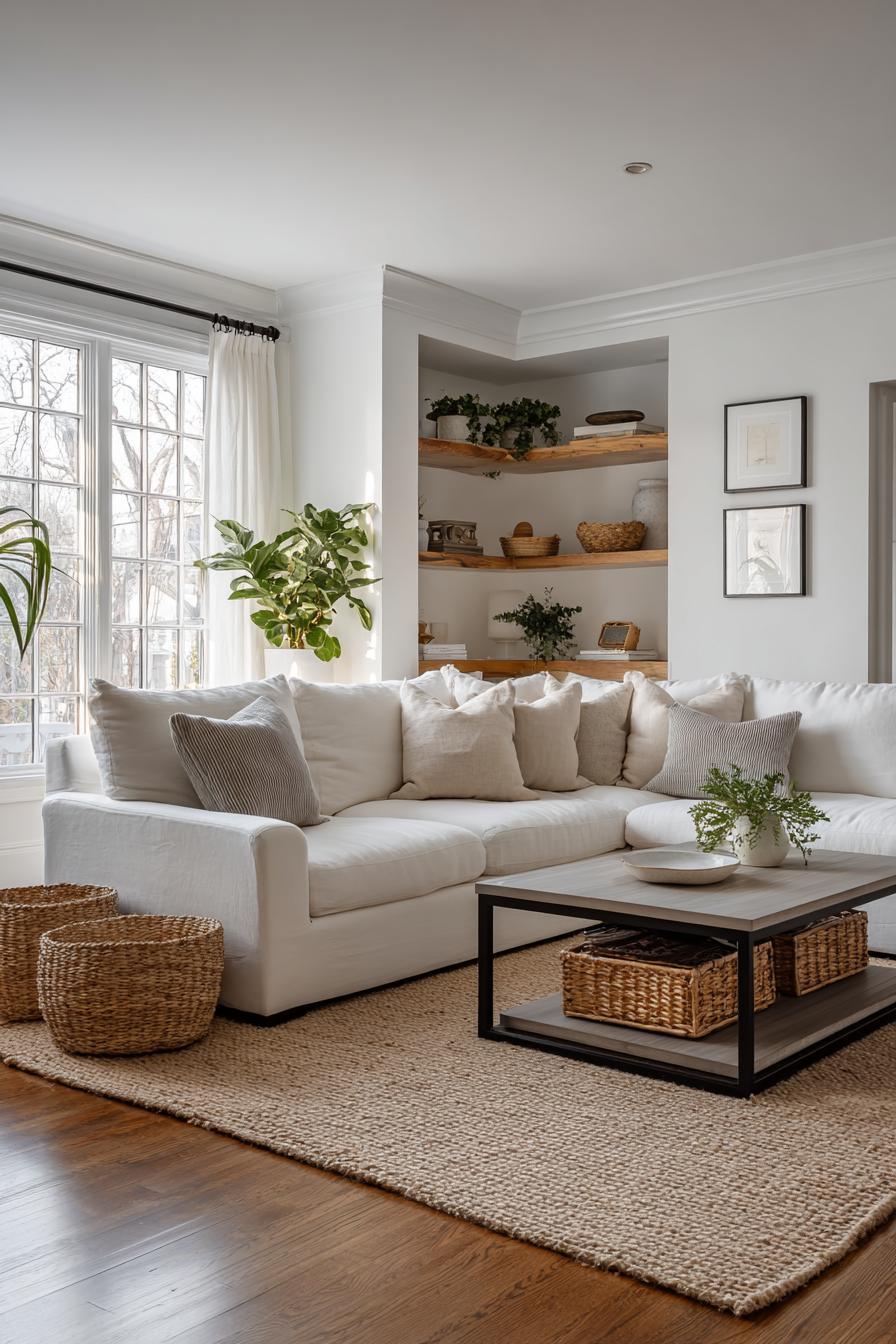
Start with intentional minimalism. Keep only what you need, love, and use regularly. Each item in your living room should have a purpose or bring joy. This approach allows the cozy elements—like throws, candles, and personal items—to shine without visual noise.
Invest in smart storage solutions to keep necessities out of sight. Baskets, ottomans with hidden compartments, and stylish cabinets can help you stay organized while contributing to the room’s aesthetic. Choose storage pieces made from natural materials to maintain harmony with your hygge theme.
Tidy surfaces and well-planned layouts promote a feeling of spaciousness, even in small rooms. Make decluttering a regular habit, and think of it not as a chore but as a way to honor your space. In a hygge home, less is often more—but every piece should count.
Seasonal Adaptations: Keeping Hygge Year-Round
Hygge isn’t reserved for winter. While the idea may conjure images of snowy nights and crackling fires, its core principles can be applied all year long by adjusting elements of your space with the seasons.
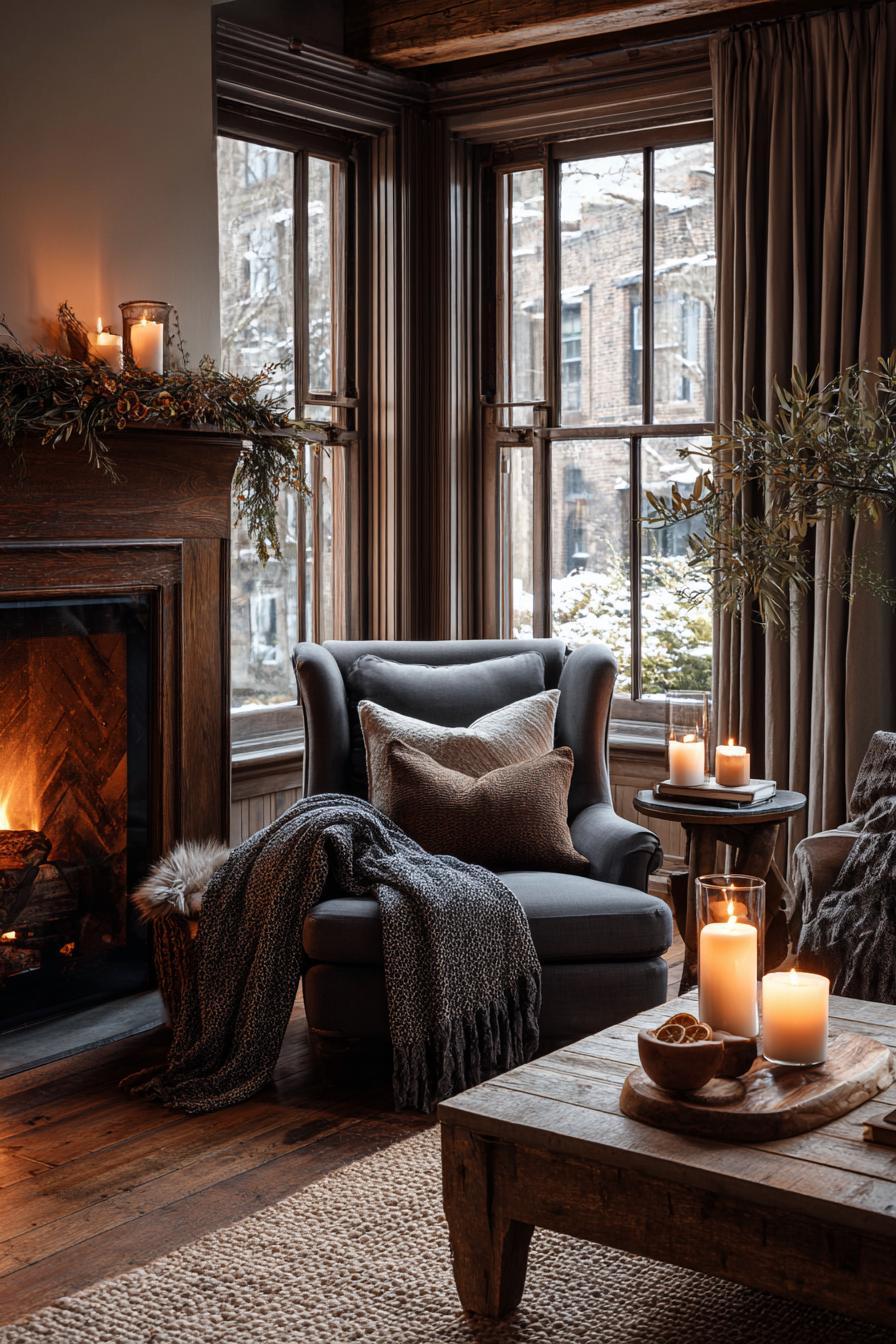
In winter, focus on thick blankets, soft lighting, and rich, warm hues. Incorporate seasonal decorations like pine branches, dried citrus, or cinnamon-scented candles to deepen the cozy vibe. It’s about embracing the indoors and finding joy in nesting.
As spring and summer arrive, swap heavier textiles for lightweight throws and breezy fabrics. Introduce fresh flowers, light scents like lavender or citrus, and pastel or airy color accents. Keep candles, but consider using unscented versions during warmer months for ambiance without heat.
Get the Fail-Safe Paint Color Playbook (Free PDF)
36 proven colors • 8 ready palettes • trim & sheen guide • printable testing cards.
Autumn offers another opportunity to refresh. Think burnt orange, golden yellows, and rustic textures like burlap or tweed. Decorate with dried leaves, pumpkins, and cozy layers to celebrate the transition of seasons.
Get the Fail-Safe Paint Color Playbook (Free PDF)
36 proven colors • 8 ready palettes • trim & sheen guide • printable testing cards.
No matter the time of year, the goal remains the same: to cultivate a living room that offers comfort, connection, and a sense of well-being, 365 days a year.
Quick Tips & Visual Checklist: Your Hygge Living Room at a Glance
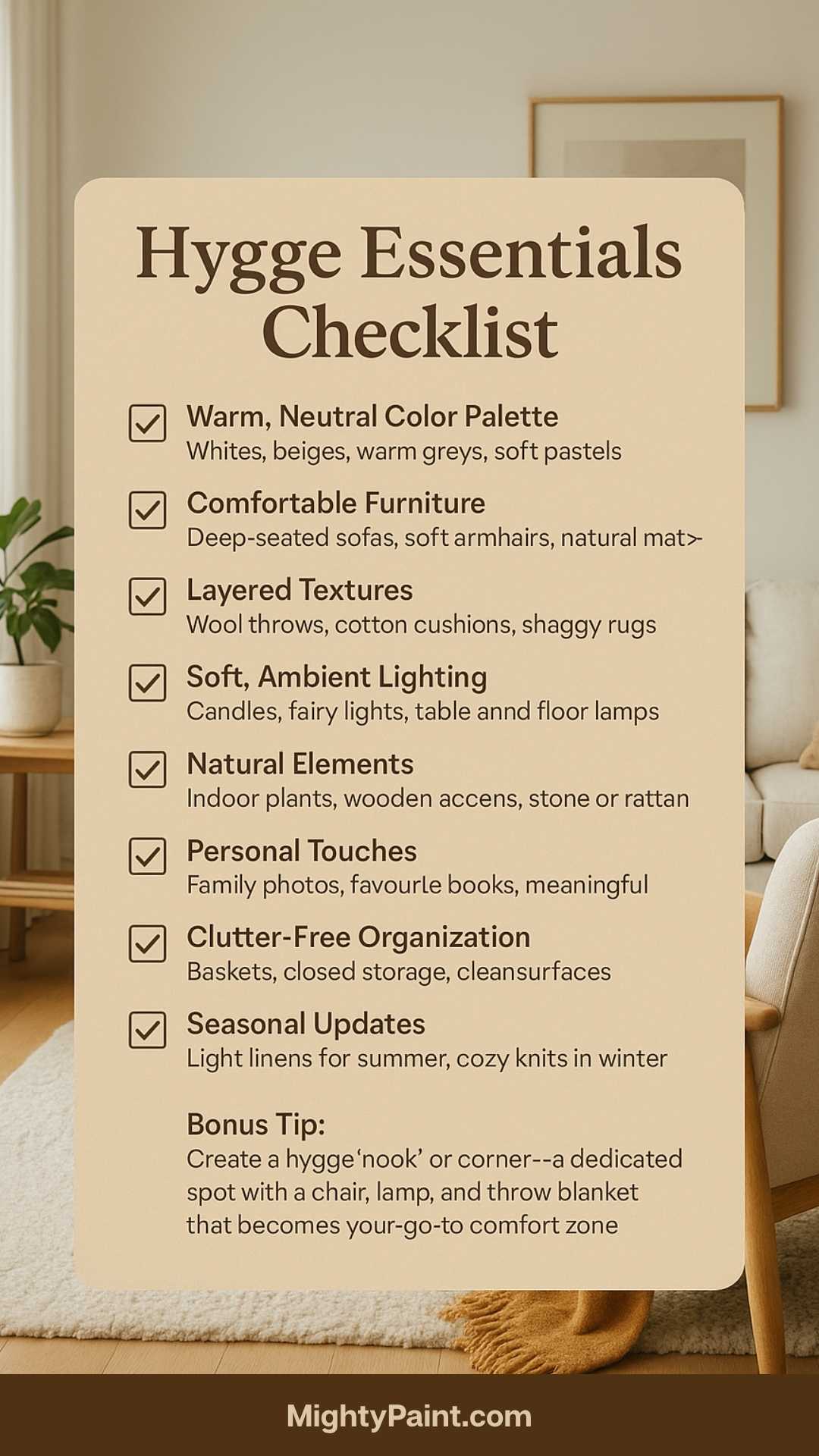
Transforming your living room into a hygge haven doesn’t have to be overwhelming. Use this quick checklist to stay focused on what really matters:
✔️ Hygge Essentials Checklist
- ☑ Warm, Neutral Color Palette – Whites, beiges, warm greys, soft pastels
- ☑ Comfortable Furniture – Deep-seated sofas, soft armchairs, natural materials
- ☑ Layered Textures – Wool throws, cotton cushions, shaggy rugs
- ☑ Soft, Ambient Lighting – Candles, fairy lights, table and floor lamps
- ☑ Natural Elements – Indoor plants, wooden accents, stone or rattan decor
- ☑ Personal Touches – Family photos, favorite books, meaningful artwork
- ☑ Clutter-Free Organization – Baskets, closed storage, clean surfaces
- ☑ Seasonal Updates – Light linens for summer, cozy knits in winter
🛋 Bonus Tip:
Create a hygge “nook” or corner—a dedicated spot with a chair, lamp, and throw blanket that becomes your go-to comfort zone.
Conclusion: Cultivating Comfort Through Hygge
Designing a hygge living room is more than a decorating project—it’s an invitation to live more intentionally. At its heart, hygge is about cherishing the small moments, finding beauty in simplicity, and creating spaces that nurture the soul. It reminds us that true comfort isn’t just about soft cushions and warm lighting, but about feeling at peace in your environment.
Whether you’re starting from scratch or simply adding a few cozy touches, embracing hygge doesn’t require a big budget or a complete overhaul. It’s about making thoughtful choices that prioritize warmth, well-being, and connection. From soft textures and calming colors to meaningful decor and gentle lighting, every detail contributes to a space that feels genuinely comforting.
So take a moment, light a candle, and settle into your favorite chair. With these hygge principles in place, your living room will become
